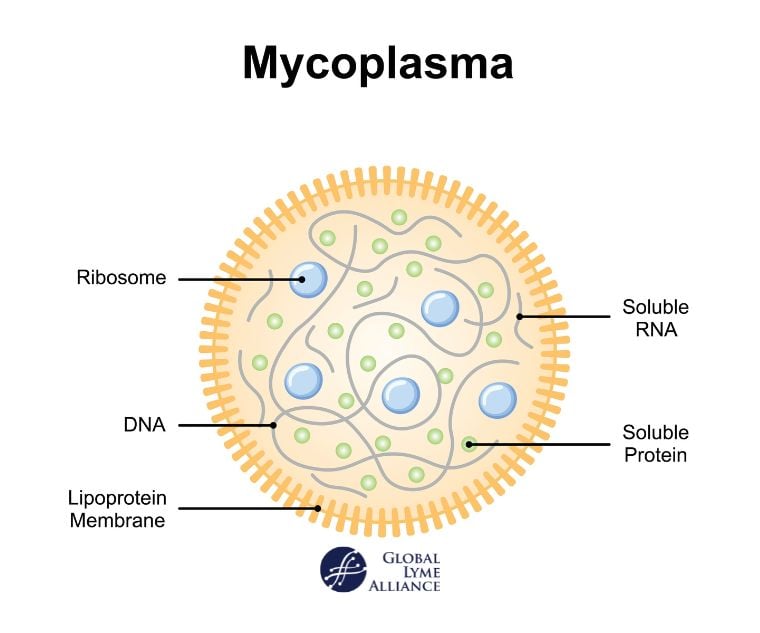
Aside from Lyme disease, you can contract other infections from ticks, such as Mycoplasma.
When you get a tick bite, you can get infections in addition to or other than Lyme disease. Ticks can transmit Borrelia burgdorferi, the bacteria that causes Lyme disease, but they can also transmit pathogens that cause other diseases. These other tick-borne illnesses are often referred to as Lyme disease co-infections, or simply co-infections (because you can have one of them without having Lyme). Let’s walk through what co-infections are, and specifically focus on one called Mycoplasma.
What Are Lyme Disease Co-infections?
A majority of people with Lyme disease have at least one co-infection. Ticks can often carry multiple infectious organisms. Black-legged ticks can carry Borrelia Burgdorferi and many other pathogens, while other types of ticks that don’t carry Lyme can still carry other diseases. It’s important to know what type of tick bit you (see GLA’s Tick Table) and to talk to your doctor about the possibility of co-infections. Each co-infection can have different specific symptoms, but some have similar symptoms to Lyme, so your doctor needs to consider all tick-borne illnesses when making a differential diagnosis.
Co-infections can be a:
- Bacteria
- Virus
- Parasite
This means they can cause bacterial infection, viral infection, and parasitic infection, some becoming systemic infections that lead to chronic illness. Lyme co-infections like Powassan virus be life-threatening, and others can be life-threatening if left untreated. One can even cause a severe allergic reaction (Alpha-gal syndrome, a serious allergy to red meat). While some co-infections can be treated with the same antibiotic therapy as Lyme disease, others require different types of treatment, which is why it is especially important to make sure you are accurately diagnosed with co-infections. Left untreated, co-infections can turn into chronic infections just as untreated Lyme can become chronic Lyme disease.
How Can Lyme Disease Co-Infections Affect Lyme Disease?
Lyme disease co-infections cause symptoms in addition to the already common Lyme disease symptoms, which may result in a more severe case of Lyme disease. The immune system acts differently when it is being attacked by several infections. Treatment for Lyme disease can be complicated and can vary based on what co-infections you have.
Different Types of Co-infections
Common co-infections include:
- Anaplasmosis
- Babesiosis
- Bartonella Henselae—Cat Scratch Disease
- Borrelia Miyamotoi
- Bourbon virus
- Colorado Tick Fever
- Ehrlichiosis
- Heartland virus
- Mycoplasma
- Powassan encephalitis
- Relapsing fever
- Rocky Mountain Spotted Fever
- Southern Tick-Associated Rash Illness (STARI)
- Tick paralysis
- Tularemia
For information on each of these co-infections, please see GLA’s Common Tick-Borne Diseases (TBDs) page.
What is Mycoplasma?
Although not necessarily transmitted along with the Borrelia bacterium via an infected tick, Mycoplasma species (such as Mycoplasma fermentans, Mycoplasma pneumoniae, and Mycoplasma genitalium) are often present in Lyme disease patients. In his book How Can I Get Better? An Action Plan for Treating Resistant Lyme & Chronic Disease, Richard I. Horowitz, MD says, “It is difficult to know the exact role that Mycoplasma species are playing in patients with Lyme disease, since the blood tests are unreliable and the signs and symptoms overlap those of other diseases.” He explains that Mycoplasma may exacerbate symptoms of other tick-borne illness, “especially for patients who present with autoimmune manifestations.”[i]
Symptoms of Mycoplasma
Whereas Mycoplasma pneumoniae causes a respiratory infection called Mycoplasma pneumoniae infection, Mycoplasma fermentans causes different symptoms. Smaller than bacteria, they invade all cells throughout the body and disrupt the immune system. This can cause:
- Severe fatigue
- Joint pain
- Nausea
- Neuropsychiatric problems
How is Mycoplasma Detected?
Mycoplasma can be detected through a blood test. Studies of blood samples have also shown Mycoplasma species in patients with rheumatoid arthritis and chronic fatigue syndrome. [ii,iii]
Think You May Have a Mycoplasma Infection?
If you think you may have a Mycoplasma infection, it’s important to see a Lyme Literate Medical Doctor (LLMD) to be evaluated for Lyme, Mycoplasma, and other tick-borne illness.
[i] Horowitz, Richard I., MD. How Can I Get Better? An Action Plan for Treating Resistant Lyme & Chronic Disease. New York: St. Martin’s Griffin, 2017 (129).
[ii] https://pubmed.ncbi.nlm.nih.gov/9879928/
[iii] https://www.ncbi.nlm.nih.gov/pmc/articles/PMC2734754/
Click the link below to sign up for GLA's newsletter.
The above material is provided for information purposes only. The material (a) is not nor should be considered, or used as a substitute for, medical advice, diagnosis, or treatment, nor (b) does it necessarily represent endorsement by or an official position of Global Lyme Alliance, Inc. or any of its directors, officers, advisors or volunteers. Advice on the testing, treatment or care of an individual patient should be obtained through consultation with a physician who has examined that patient or is familiar with that patient’s medical history.








